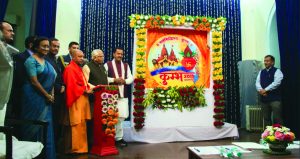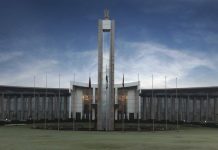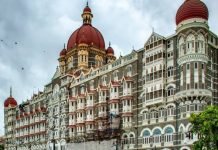 BJP government of Uttar Pradesh led by Yogi Adityanath has started branding of ‘Kumbh Mela’ in Prayagraj as a symbol of cultural nationalism and ancient center of Hindu pilgrimage based on the religious mythology. With fiscal support of more than 2,800 crores, the government has opened up all its coffers to turn this mega magnificent holy ritual into a grand success for enticing unparalleled dividends in terms of pitching its political agenda across the country and abroad, blended with Hinduism. This biggest event has assumed special significance for the ruling party as it is being held just ahead of the 2019 general elections.
BJP government of Uttar Pradesh led by Yogi Adityanath has started branding of ‘Kumbh Mela’ in Prayagraj as a symbol of cultural nationalism and ancient center of Hindu pilgrimage based on the religious mythology. With fiscal support of more than 2,800 crores, the government has opened up all its coffers to turn this mega magnificent holy ritual into a grand success for enticing unparalleled dividends in terms of pitching its political agenda across the country and abroad, blended with Hinduism. This biggest event has assumed special significance for the ruling party as it is being held just ahead of the 2019 general elections.
The hi-tech concept of Kumbh Mela, 49 days long event, has been planned in a professional way as it is considered to be the largest peaceful congregation of pilgrims on earth that may likely to attract 120 million pilgrims and tourists. The Government of India has decided to organise the 15th Pravasi Bharatiya Divas in partnership with Uttar Pradesh government on January 21-23, 2019, in the adjacent cultural and religious city, Varanasi (UP), so that the larger community of Indian Diaspora as well as foreigners may be attracted to participate in prestigious Kumbh Mela and Republic Day celebrations. Prayag Mela Authority is expecting around 5,000 such dignitaries to join Kumbh celebrations. It has also earmarked designated area for 192 countries and a flag hoisting ceremony of their head of mission has been planned in the month of December 2018.
UNESCO recognised Kumbh Mela as an ‘Intangible Cultural Heritage of Humanity.’ It has a history that dates back to thousands of year, right from the era of Adi Shankaracharya. Intangible cultural heritage means the practices, representations, expressions, knowledge, skills — as well as the instruments, objects, artifacts and cultural spaces associated with them that communities, groups and, in some cases, individuals recognize as a part of their cultural heritage. The grandeur of the cultural extravaganza celebrated at four different cities in India, over a period of 12 years, draws throngs of devotees seeking spirituality and nirvana, bathing at sacred rivers to purify their sins. The festival, held in Allahabad, Haridwar, Ujjain and Nasik, represents a syncretic set of rituals related to worship in India.
One of the most popular and astonishing mythological stories found in ancient Indian texts is ‘Amrita Manthan’ that is, churning of the ocean for nectar, the celestial water of immortality. It narrates that once the gods and demons agreed to churn the great ocean and share the treasures or the ‘Ratnas’ (Jewels) that will emerge from it. The most precious treasure emerged was ‘Amrita’, the nectar. Both the gods and the demons laid claims to it. One who drinks will become immortal and therefore, all-powerful and indestructible. Gods could never accept this. This resulted in scuffle between them for a pot of nectar (Amrit Kumbh), the nectar of immortality. Lord Vishnu, disguising himself as an enchantress (Mohini), seized the nectar from the demons. While fleeing from the evil ones, Lord Vishnu passed the nectar on to his winged mount, Garuda. The demons finally caught up with Garuda and in the ensuing struggle, a few drops of the precious nectar fell on Allahabad, Nasik, Haridwar and Ujjain. Since then, the Kumbh Mela has been held in all these places, alternatively, every 12 years.
The preparations for the Prayag, (Allahabad) Kumbh Mela for January 2019 are in full swing. Prayag has been known as most sacred pilgrimage places for the Hindus, situated at the confluence (Triveni Sangam) of the Ganga, the Yamuna, and the mystical Sarasvati. Hindu saints sporting dreadlocks, smoking chillums (pipes) or practicing complex Asanas (poses) use to be common admirable sights for one and all. The whole atmosphere is glittered and charged with chiming bells, incense and flower fragrance scattering flawlessly with the smoke from the ‘Havan Kunds’ (fire spaces), Preaching from saints of different sects of Hinduism, Vedic Hymns, Mantras, Drumbeats, the blast of conchs and the ring of holy bells. Apart from bathing rituals, elucidations, traditional dances, devotional songs, programs based on mythical stories, and prayers are also unique feature of this event. Religious assemblies are held where doctrines are debated, standardized and conducted by renowned saints and sages. An auspicious element of the festival is the act of benevolence to liberally offer donations to the poor, helpless, saints, and to feed or donate cows to priest. Donations range from basic food and clothing to even precious metals. The Kumbh Mela is perhaps the only event in the world where no invitation is required yet millions of pilgrims gather to celebrate the holy event.
Witness the sea of fervent devotees performing their rituals and offering prayers or choose to visit the various Akharas to get comprehensive view on the ideology and philosophy of different sects of Hinduism. Akharas came into existence during the 8th century AD when Adi Shankaracharya established seven Akhadas namely Mahanirvani, Niranjani, Juna, Atal, Avahan, Agni and Anand Akhara with an aim to strengthen the Hindu religion and unite those practicing different rituals, customs and beliefs. Akharas are divided into different camps according to the concept of God they worship. Shaiva Akharas are for followers of Lord Shiva, Vaishnava or Vairagi Akhara are for followers of Lord Vishnu and Kalpwasis are for followers of Lord Brahma.
The Yogi government has already allotted 2,800 crore for this 49-day Kumbh festival, two and a half times more than erstwhile Akhilesh Yadav government that organised ‘Maha Kumbh’ in 2013 in Allahabad. This time the area in Allahabad for the upcoming festival on the river bed has been increased from 1,936 hectares in 2013 to over 3,200 hectares besides, increasing the number of sectors of the Mela area from 14 to 20 for its better management. “It’s a very challenging task to manage such a huge crowd and provide them facilities of transport, medical assistance, food and lodging, shelter and safety. Health and sanitary services are also a big challenge in view of such a big crowd. We have been organizing it with active coordination of all other departments,” said Commissioner Prayag (Allahabad) Ashish Kumar Goel.
There would be at least 5000 religious and social organisations who have lined up to put up camps during Kumbh. The expectation of pilgrims inflow could be around 12 crore. Maximum 3 crore pilgrims are expected on Mauni Amavasya and the daily floating population is expected to be around 20 Lakh every day. The numbers of Kalpvasis during the entire festival could be 20 Lakh. Prayag Mela Authority estimates to receive near 10 Lakh foreign tourists in this period.
The police administration has been deeply involved to ensure smooth movement and safety of pilgrims who are coming not only from India but from the different countries of the world. With the budgetary support of 84.84 crores, construction, development and renovation work of multiple Police stations and hostels is going on. There are four Police lines including 40 police stations, 3 female police stations and 62 police out posts are under construction at the site. 40 Firefighting centers, 15 fire out posts and 40 watch towers have to be built during Mela period. In the interest of better crowd management and surveillance an ultra-modern Integrated Command and Control Centre is being established that will keep an eye on every nook and corner. Over 1,000 cameras will be placed to monitor ongoing activities in the city and Mela area. A detailed action plan for disaster management has to be carried out. It includes deep water barricading, floating river line, temporary fire stations, and control towers. State-of-the-art equipment, such as wireless/radio sets, fibre jetties, body worn cameras, drone cameras etc. have been procured to deploy.
The Sangam Nivas Camp will offer exceptional services such as Unlimited Wi-Fi at the Reception Tent, 24/7 security and paramedic on site, 24/7 electricity, the library at Reception Tent, Wellness Center for rejuvenation and Temple for the evening ‘Aartis’. Each tent has an
ensuite bathroom with access to 24 hours running hot and cold water. One can choose from a one-night to a five-night itinerary to enjoy the best of the religious fervor. The camp has weaved in exclusive activities specially curated to enhance the Kumbh Mela experience. Public accommodation, with a capacity of 20,000 beds, is being setup. These camps will be saturated with basic amenities and security arrangements. 4,200 premium tents are planned to be set up in the Mela area for tourists. These tents will be built and operated on PPP basis. Four Convention halls will be built in each zone for cultural programs, exhibitions and arts gatherings. A Ganga Pandal for preaching of sacred religious sermons has also to be built up in the area for organizing cultural, spiritual and official programmes with a capacity to accommodate 10,000 people.
The Tourism and Culture Department infrastructure is being upgraded along with key tourist sites at the cost of 20.99 crores. “Laser light and sound show, Façade Lighting and Packaged tours will be organized by the department for pilgrims to have enriched experience about Indian art and culture. Thirty thematic gates marking the approach roads and entrances to the various sectors and city will also be designed and developed. Tourist walks for Heritage, Cuisine, Religious Shrines etc is being planned. More than 200 cultural events by best artists/organizations would be added attraction during the Mela period,” Principal Secretary of the department Awanish Awasthi revealed while talking to ‘Tehelka’. “Four media centers will be built in Kumbh Mela area to showcase the event to the entire World. All the centers will be equipped with ultra-modern technologies,” he added.
The government of India had included Allahabad in its Smart City project. The project is designed to increase infrastructure to make it ideal city. A lot of developmental work is being carried out on priority basis in view of Kumbh Mela. Renovation work at multiple hospitals, development of new wards and purchase/upgradation of medical equipment is being done with the allocation of 73 crores. The UP government has sanctioned 7.11 crore to transport department for construction of passenger halls and other development works for bus depots.
Major infrastructural project worth 1,388.28 crores has been undertaken by State Public Work Department for widening of 116 roads in Allahabad and its surrounding areas. More than 125,000 iron checkered plates will be used for the construction of 600 kms roads in the Mela area, besides developing 22 Pontoon bridges using 1,795 Pontoons. Similarly with a cost of 47.61 crore State Irrigation Department has been executing development seven Ghats and riverfront conservation work. Allahabad Development Authority has also got 298.35 crores funds for strengthening and widening of 34 roads of the city including redesigning, refurbishing and beautification work at 32 different traffic junctions. The UP State Bridge Corporation has almost constructed 10 road-over bridges (R.O.B.) with a budget allocation of 501.89 crores.
Government of India has been regularly monitoring Kumbh works closely. National Highways Authority of India (NHAI) is rebuilding and upgrading Allahabad — Pratapgarh Highway, Raebareli — Allahabad Highway and Varanasi — Allahabad Highway for smooth movement of traffic during Kumbh Mela. Inland Waterways Authority of India under the supervision and direction of BJP stalwart and its minister Nitin Gadkari is building Jetties at 5 places and planning to start point to point ferry services for Pilgrims. It will be unique support added first time to Kumbh Mela. Upgradation of 9 railway stations, development of 9 ROBs and expansion of 6 RUBs is underway and is almost completed. A new terminal is being constructed at the Allahabad Civil Airport and is expected to be completed by the end of this month.
Adityanath has been sensitive enough to monitor each and every arrangement to showcase his political and administrative worth in the saffron party as the BJP will certainly going to capitalize the event for its future political prospects.
letters@tehelka.com











